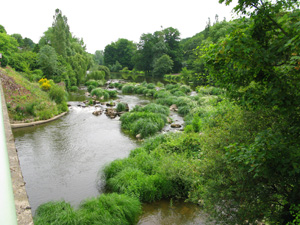| Vendee Information Vendee History Accommodation, Photos, Reviews, Maps, |
Sèvre Nantaise River
Sud
Vendee.. Haut
Bocage.. Coastal
Region.. Marais
Poitevin.. Marais
Breton.. Bas Bocage.. Plaine.. Marais
Olonne..
The source of the
river is just north of Niort in the department of Deux-Sèvres near the village of
Secondigny. The Sèvre Nantaise forms the boundary between the departments Deux-Sèvres
and the Vendée from St.Mesmin to 5 kilometres south of Mallièvre
where it enters the Vendée proper. Its journey through the Haut
Bocage continues past the Valley-du-Poupet, St.Laurent-sur-Sèvre on past Mortagne-sur-Sèvre before again forming the boundary this time
between the Vendèe and the Maine-et-Loire and then the Loire Atlantique
departments before leaving the Vendèe at Clisson and
continuing northwards to join the mighty Loire River.
The Sèvre Nantaise is
not only the prettiest river in the Vendée but has also been deeply involved in
the history of the region. It is historically the boundary between the major
regions that have controlled this part of France since prehistoric times,
starting with the Celts to the north and the Pictons to the south. In Medieval
times it was the confluence between the three provinces of Poitou, Anjou and
Brittany and with the Revolution the region was divided up between the current
Departments of Vendée , Deux Sèvres, Loire et Maine and Loire Atlantique.
The 159 kilometre long river starts at an elevation of 215m and the
resulting drop has allowed for its power to be harnessed to drive industrial
machinery. This started in the XI century and resulted in the great industrial
revolution of the Vendée with some 145 water mills driving such diverse trades
as paper making, tanning, cloth and wool weaving, fuller mills for degreasing
and felting woollen fabrics, mills for washing and dying cloth, thistle mills
with teasel covered drums for finishing woollen fabrics, powder-mills for
crushing charcoal, saltpetre and sulphur and mills grinding grain. France’s last
working water driven wool mill can be visited at Foulon
near Cugand.
Of these 145 mills the majority were for grinding grain though nearly a third
were involved in the fulling or woollen industries and it was therefore not
surprising that towns and villages sprung up along the river with trades needed
to augment these mills such as weavers, spinners cloth merchants, dyers,
carpenters and wheel-wrights, forges and blacksmiths, stationers and transport
specialists.
Although most of these mills no longer continue their trades
their legacy is priceless and the many weirs and waterways that were needed to
store and divert the water power now provide idyllic settings on this
gently meandering river. It also provides ideal conditions for canoeing and
kayaking and picturesque settings for artists and photographers.
History has
left us with some memorable attractions, besides the water mills with their
weirs namely the boundaries between the differing provinces which have left a
string of medieval castles from St. Mesmin,
Châteaumur, Mortagne-sur-Sèvre, Tiffauges
and Clisson. Where there are castles then religion is never very far away and
the most notable representation of this is the holy town of St.Laurent-sur-Sèvre
with its magnificent basilica and many other churches, convents and religious
buildings. Also of note along the river are the medieval wall paintings in the
church at la Pommeraie-sur-Sèvre.
The Vendèe's only Stream
railway starts at Mortagne-sur-Sevre and run through the Haut bocage
crossing the Sèvre Nantaise on the Viaduct Barbin above the glorious Parc
du barbinière on its way to les
Epesses.
Tributaries of the River Sèvre Nantaise. There is only one in
the Vendèe, The River Grande Maine, that rises in the Vendée and with its
smaller sibling La Petite Maine it joins the Sèvre Nantaise a few kilometres
before the confluence with the mighty River Loire at Nantes.
The Grande Maine
rises north of Les Herbiers near the Puy du Fou and flows North West to
St.Georges Montaigu where it is joined by the Petite Maine which rises near les
Essarts. The river then flows north through Montaigu
before leaving the Vendèe.
Campsites along the Sèvre Nantaise River.
St.Laurent-sur-Sèvre. Camping le Rouge Gorge, route
Verrie. Tel. 02 51 67 86 39.
St.Malo-du-Bois. Camping Manicipal
Poupet. Tel.02 51 92 31 45.
Tiffauges. Camping la
Vallée, Le Vatican, Tiffauges. Tel.02 51 65 75 65
Return to find more
Attractions of the
Vendée
In
accordance with the law "and Freedoms" of January 6, 1978, you have the right to
access and rectify information concerning you. If you wish to exercise this
right, please contact
us.
© Copyright Vendee-Guide.co.uk 2009-10
© Copyright Vendee-Guide.co.uk 2009-10
Loading
